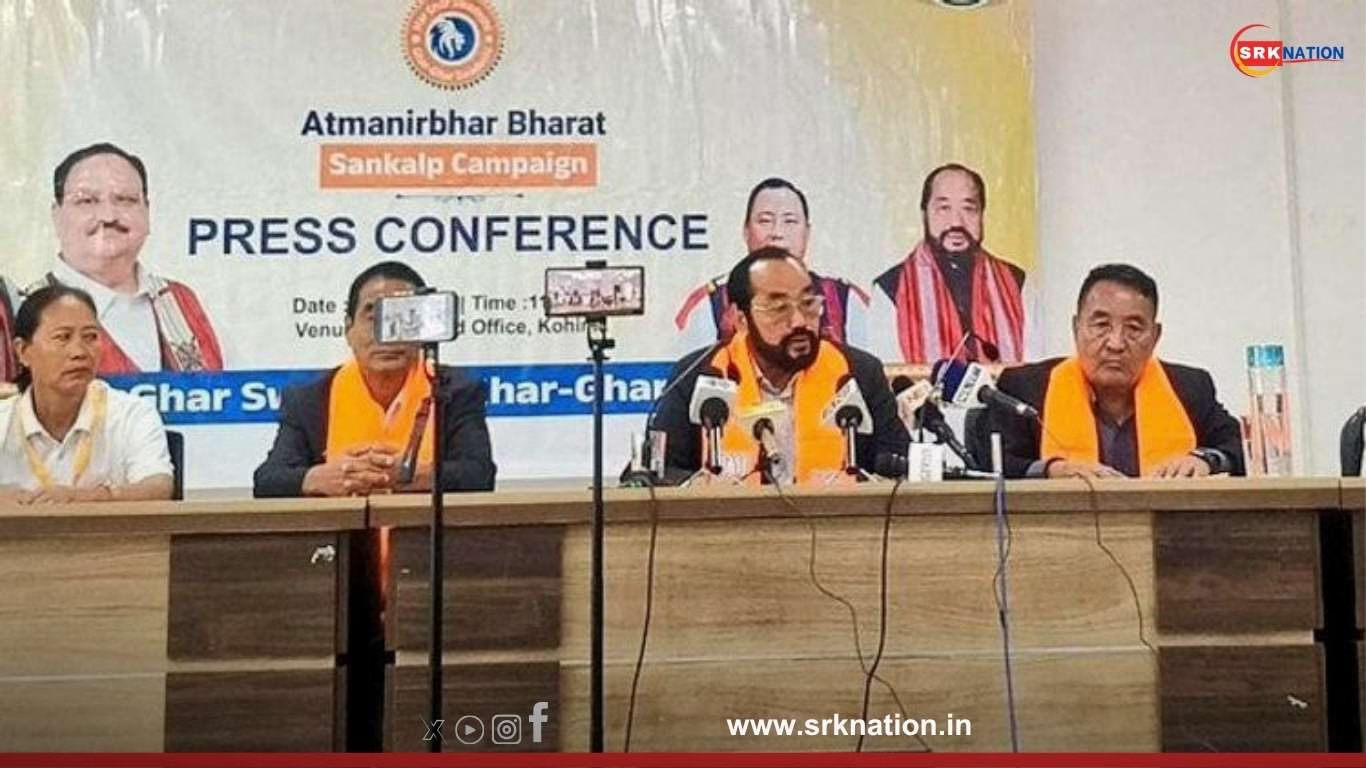The Meghalaya government has initiated the long-planned relocation process of over 400 street vendors from Shillong’s Khyndailad (Police Bazaar) and adjoining areas to designated vending zones as part of urban decongestion and organised market development. The move, however, sparked widespread protests by vendors who alleged inadequate consultation, fear of income loss, and poor infrastructure at the new sites despite the government’s announced ₹20,000 one-time relocation allowance for each vendor.
Government’s Relocation Plan
The relocation drive was carried out under the provisions of the Street Vendors (Protection of Livelihood and Regulation of Street Vending) Act, 2014 and Shillong Municipal Board regulations. It seeks to shift vendors operating in no-vending and high-traffic zones to dedicated vending markets with proper stalls, water, and sanitation facilities.
Chief Minister Conrad K Sangma, speaking to reporters, said:
“Our objective is to ensure both vendor livelihoods and public convenience. The ₹20,000 relocation allowance will help them transition smoothly while the government ensures infrastructural support at vending zones.”
Key Details of Shillong Street Vendor Relocation
| Particulars | Details |
|---|---|
| Total vendors targeted | ~400 |
| Areas of relocation | Khyndailad (Police Bazaar), Iewduh, Motphran |
| New vending zones | Mawlonghat, Polo Market extension |
| Allowance provided | ₹20,000 one-time relocation assistance |
| Implementing bodies | Shillong Municipal Board, Urban Affairs Department |
| Legal basis | Street Vendors (Protection of Livelihood) Act, 2014 |
| Timeline | July-August 2025 |
Vendor Protests and Concerns
Hundreds of street vendors staged demonstrations outside the Shillong Municipal Board office and in Khyndailad area carrying placards reading “We Want Right to Livelihood”, “No Forced Eviction Without Consultation.”
Key grievances raised by vendors:
- Lack of direct consultation before finalising relocation sites.
- Poor infrastructure including inadequate roofed stalls and sanitation at the new sites.
- Fears of reduced customer footfall leading to income loss.
- Insufficient transitional financial support beyond the ₹20,000 allowance.
Vendor Relocation Grievances vs Government Response
| Vendor Grievance | Government Response |
|---|---|
| No direct consultation | Consultations held with registered vendor unions since January 2025 |
| Poor infrastructure at new sites | Infrastructure development ongoing; ₹5 crore allocated |
| Fear of losing customers | Awareness campaigns and transportation link plans being implemented |
| Inadequate financial support | ₹20,000 allowance plus free stall allocation announced |
Urban Affairs Department Clarification
Urban Affairs Minister Sniawbhalang Dhar stated:
“We are relocating in compliance with Supreme Court guidelines to decongest high-traffic areas. Vendors will be provided proper stalls, drinking water, electricity, and sanitation. Transitional challenges will be addressed through dedicated grievance redressal cells.”
Stakeholder Perspectives
Shillong Municipal Board
Municipal officials highlighted how unregulated vending had led to severe pedestrian congestion, waste management issues, and traffic bottlenecks in Shillong’s core business district.
Vendor Unions
Vendors’ union leaders argued that while organised markets are welcome, forced eviction without adequate rehabilitation violates the Street Vendors Act’s spirit of protecting livelihoods.
Street Vendors (Protection of Livelihood and Regulation of Street Vending) Act, 2014: Key Provisions
| Provision | Explanation |
|---|---|
| Survey of vendors | States must conduct surveys every five years and issue identity cards. |
| No eviction without rehabilitation | Vendors cannot be removed without rehabilitation in vending zones. |
| Formation of TVC | Town Vending Committees (TVCs) must have vendor representation to decide vending plans. |
| Protection of livelihood | Recognises vendors’ right to earn and occupy public space with regulation. |
Shillong Vendor Survey: Key Data
| Parameter | Data (2025) |
|---|---|
| Total vendors surveyed in Shillong | 1,345 |
| Vendors in Khyndailad-Police Bazaar | ~400 |
| Vendors registered with TVC | 1,102 |
| Women vendors proportion | ~65% |
Source: Shillong Municipal Board & Urban Affairs Department
Expert Opinion
Urban policy expert Dr. Phidalia Toi of NEHU said:
“The relocation drive is necessary for organised urban planning but must balance livelihood protection. Adequate stakeholder consultation, inclusive planning, and quick infrastructure provisioning are crucial to avoid social unrest and legal challenges.”
Recent Similar Relocations in Northeast
| City | Year | No. of Vendors Relocated | Key Outcome |
|---|---|---|---|
| Guwahati | 2023 | ~750 | Successful with phased infrastructure readiness |
| Agartala | 2024 | ~300 | Faced protests; improved after government doubled relocation allowance |
| Dimapur | 2024 | ~450 | Partial success; poor market infrastructure remains a challenge |
Challenges Ahead
✅ Ensuring quick completion of market infrastructure before full relocation
✅ Maintaining vendor income levels to avoid social distress
✅ Preventing unregulated re-vending in no-vending zones post relocation
✅ Continuous grievance redressal and effective Town Vending Committee functioning
Future Government Plans for Vendors
The Urban Affairs Department has proposed:
- Establishment of Vendor Welfare Board for health insurance and microfinance support.
- Integration of vendor markets with tourism and local handicraft promotion to boost sales.
- Capacity building workshops for vendors on digital payments and waste management compliance.
Political Reactions
Opposition parties including the Meghalaya Pradesh Congress Committee termed the relocation drive “inhuman and forced eviction without viable rehabilitation” and demanded an independent review.
In response, the ruling National People’s Party (NPP) defended the move citing legal compliance, urban decongestion benefits, and the ₹20,000 allowance as evidence of “sensitive rehabilitation policy.”
Conclusion
The Shillong street vendor relocation marks a crucial urban governance intervention to address congestion while aiming to uphold vendor livelihoods. Its success, however, hinges on:
- Genuine vendor consultation
- Timely infrastructure readiness
- Adequate financial and social support for seamless transition
As Meghalaya navigates urban modernisation and inclusive growth, the relocation process will remain a litmus test for its governance approach towards marginalised urban informal workers.
Disclaimer: This article is for informational purposes only. Readers are advised to follow official Shillong Municipal Board and Urban Affairs Department notifications for verified updates related to street vendor relocation, allowances, and market infrastructure readiness.











